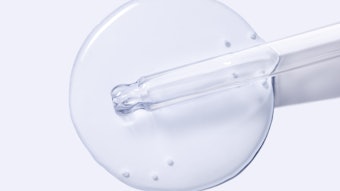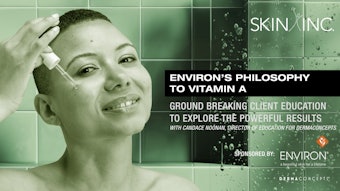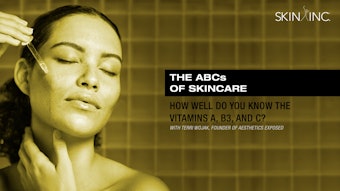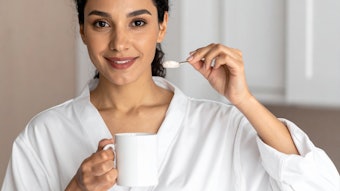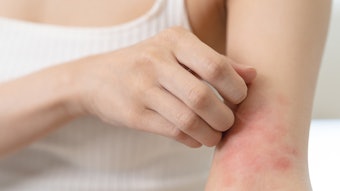
Is Your Sunscreen Doing More Harm Than Good?
Editor’s note: This article from the May issue of Skin Inc. magazine has sparked a lot of recent debate about ingredients in sunscreens. Following is excellent insight from a variety of ingredient experts, as well as the author of the article, Rhonda Allison. This information should help you determine your stance on the issue, and provide you with all the information you need to respond to your clients’ questions on this complex topic.
“In your April, 2012, issue, the article “Is Your Sunscreen Doing More Harm Than Good?” stated: ‘Octinoxate (octyl methoxycinnamate)—an estrogenic chemical that has been linked to hormonal imbalance and increased rates of cancer,’ citing the article ‘Endocrine activity and developmental toxicity of cosmetic UV filters—an update’, by M Schlumpf, et. al, Toxicology 1 205 113–122 (Dec 2004) as the source.
I’d like to make it very clear that octinoxate—the most common sunscreen ingredient in the world—does not cause cancer. Statements to the contrary are made every few years by journalists or representatives of cosmetic brands that don’t use octinoxate in their products. I do not know if this is the case here. Because there is no study that proves octinoxate causes cancer, the phrase ‘linked to cancer’ is often used instead of ‘proven to cause cancer.’ In some studies where octinoxate is ‘linked’ to cancer, the ingredient has been placed in high concentrations directly onto various types of cells taken from skin or other areas of the body, such as the liver or uterus, or was fed to rats or mice in their food. Neither of these test methods would be considered valid if one was trying to prove octinoxate, as used in sunscreens, caused cancer.
In other instances, epidemiologists have connected the rise in skin cancer rates with sunscreen use. However, no individual sunscreen has been shown to be at the root of this increase. Instead, most researchers believe the SPF number, which applies only to UVB protection, leaves skin open to damage by UVA. Both UV rays are known contributors to skin cancer. This year, the U.S. Food and Drug Administration (FDA) is seeking to resolve this issue by making it mandatory for sunscreens claiming UVA protection to clear FDA-approved UVA efficacy tests prior to going to market. Other recent regulations focus on delivering the stated SPF protection during the product’s use. This includes removing SPF claims from makeup powders, including mineral makeup, since the amount of product applied cannot deliver the stated SPF. With these and other refinements in sunscreen regulations, the FDA is seeking to reduce the rate of skin cancer in the United States.
In the study listed as the source for the article’s octinoxate hormone and cancer claims1, conducted by researchers at the University of Zurich in Switzerland in 2004, evidence of endocrine (hormone) disruption activity in rats fed octinoxate was found, but no endocrine disruption was determined in humans applying sunscreen to their skin. The researchers did not find a link to cancer as your author seems to imply. Shortly after the 2004 study was published, another research group in Australia found detectable amounts of octinoxate in the stratum corneum and epidermis 24 hours after applying the ingredient to intact skin, but the amount identified was five times less than studies where octinoxate was applied directly to human keratinocytes in a Petrie dish.2 Even the Skin Deep Report published by the Environmental Working Group (EWG) states there is ‘no information’ about octinoxate as a cause of cancer.3 If there were published studies, they would definitely be reported by the EWG due to the group’s ongoing monitoring of problematic issues concerning sunscreens.
I am concerned that, after reading this article, estheticians and their clients will stop using octinoxate, which is a highly effective UVB sunscreen used in many sunscreens throughout the world. Thank you for giving me the opportunity to set the record straight.”
Rebecca James Gadberry Instructor
Cosmetic Sciences, UCLA Extension
CEO, YG Laboratories
1. M Schlumpf, et al, Endocrine activity and developmental toxicity of cosmetic UV filters—an update, Toxicology 205 1–2 113–122 (Dec 1, 2004 2. CG Hayden et al, Sunscreen penetration of human skin and related keratinocyte toxicity after topical application, Skin Pharmacol Appl Skin Physiol 18 170–174 (2005) 3. www.ewg.org/skindeep/ingredient.php?ingred06=704203 (Accessed Jun 4, 2012)
“Last month’s ‘Is Your Sunscreen Doing More Harm Than Good?’ highlighted some of the common safety concerns about sunscreens. When questioning the safety of ingredients, it is important to dig deep into the complex safety studies. As an example, here are some common ‘dangerous’ ingredients and the truth.
Oxybenzone is widely used and is an effective sunscreen filter. In animal models (at high doses) it is absorbed systemically and produces hormone disruptive effects. What is often not mentioned is that there is a follow-up human study (Janjua et al.) in which 15 males and 17 females applied (2mg/cm2) a whole-body 10% oxybenzone lotion. This study showed systemic absorption of oxybenzone, but no significant disruption of hormone homeostasis as evidenced by measuring serial levels of estradiol, testosterone and inhibin B in the test subjects. There are no human studies that have shown biologically significant hormone disruptive effects from oxybenzone.
Retinyl palmitate is widely used in cosmetics and even commonly as an additive to fortify foods. In skin, the storage form of retinol is retinyl palmitate. In vitro studies have shown that retinyl palmitate produces reactive oxygen species (ROS) when exposed to UV light and, as such, might be carcinogenic. However in vivo studies with mice failed to show a photocarcinogenic link between retinyl palmitate and UV exposure. Where animal and in vitro models have failed to link retinyl palmitate with increased cancer risk: retinoids have been used for 40 years in clinical medicine both orally and topically to treat a variety of conditions including acne, psoriasis, photoaging and cutaneous T cell lymphoma. The long track record with these medications confirms both the safety and efficacy of retinoids, including retinyl palmitate.
The Cosmetic Ingredient Review (CIR) reviewed the safety of parabens in 1984 and concluded they were safe for use in cosmetic products at levels up to 25%. Typically, parabens are used at levels ranging from 0.01–0.5%.
However, in 2004, a study (Darbre, in the Journal of Applied Toxicology) detected parabens in breast tumors. The study discussed this information in the context of the weak estrogenlike properties of parabens and the influence of estrogen on breast cancer. The study left several questions unanswered. For example, the study did not show that parabens caused cancer, or that they are harmful in any way. Furthermore the study did not look at possible paraben levels in normal tissue. These are not insignificant flaws in the study. The lack of normal tissue as a control should have kept this study from passing the peer review board. It is worth noting that the patient in this study was in fact receiving intravenous chemotherapy, in which the preservative was parabens (at levels of approximately 40%).
Although parabens can act similarly to estrogen, they have been shown to have much less estrogenic activity than the body’s naturally occurring estrogen. For example, a 1998 study (Routledge et al., in Toxicology and Applied Pharmacology) found that the most potent parabens tested in the study, butylparaben, showed from 10,000- to 100,000-fold less activity than naturally occurring estradiol (a form of estrogen). Further, parabens are used at very low levels in cosmetics. In a review of the estrogenic activity of parabens, (Golden et al., in Critical Reviews in Toxicology, 2005) the author concluded that, based on maximum daily exposure estimates, it was implausible that parabens could increase the risk associated with exposure to estrogenic chemicals.
In conclusion, these are but three of many ingredients on the ‘hit lists’ of many self-promoting consumer advocacy groups. The misinformation about these ingredients limits a formulator’s ability to develop products from a full slate of ingredients; instead, being forced by marketing to replacing some of the best and most tested ingredients with newer compounds that may or may not be as effective, but do not have a decades-long track record.
Consumers are confused and frankly scared by a cacophony of misinformation propagated by the junk science industry. There are even physicians that only want to sell ‘chemical-free’ products. As frustrating as this can be, it also presents an opportunity for the cosmetics industry to become more proactive, and for brands to differentiate themselves by educating their customers.”
Karl Gruber, MD
CEO
LUCA Sunscreen
Editor’s note: Following is a response to these letters from Rhonda Allison, author of the article “Is Your Sunscreen Doing More Harm Than Good?” from the May 2012 issue of Skin Inc. magazine.
“Sunscreen has long been a hot topic, made even more relevant by the recent FDA rulings and changes in the way sun protection formulas are labeled. The changes have left many consumers scratching their heads, not knowing what they should be looking for and what they should steer clear of when it comes to UV protection.
In the May issue, I discussed some of the commonly used ingredients in sun-protection formulas, and the difference between chemical and mineral sunscreens. The piece was intended to shed light on the topic, discuss some of the concerns that surround UV-protection ingredients and raise the all-important issue of skin health.
In my more than 30 years in the esthetic industry, I have observed time and time again skin that has been chemically peeled, resurfaced or on topical tretinoin, that has had adverse reactions from chemical-based sunscreens. This included irritations, breakouts, congestions and, in some cases, an allergic response to the sun that impacted the skin severely. I determined that, although the sunscreen may have been preventing UV damage, the skin was not experiencing a positive outcome overall, which led me to explore other options.
Mineral blockers have proven to be most compatible with all skin types, particularly for skin that is on a corrective skin care regimen. To boot, mineral blockers, such as zinc oxide and titanium dioxide, offer an SPF of 30 and are not absorbed by the skin, which is why they don’t produce a reaction.
Although there are certainly vast amounts of research on nearly any topic imaginable and information can be found to support or contradict any viewpoint, research, personal experience and experimentation led me to know mineral blockers were effective, and promoted skin and whole body health.
The Centers for Disease Control and Prevention, during an experiment conducted in 2008 on a national scale, found the chemical compound oxybenzone (a derivative of benzophenone-3) present in 96.8% of the human urine samples tested. The purpose of the experiment was to determine whether this ingredient, which is commonly found in chemical-based sunscreens, had the ability to be absorbed by the body. Frequent reapplication, and application to large portions of the body, which is obviously recommended with sunscreen, increased the systemic absorption of the ingredient (in some cases as much as 10% of the applied dose may be absorbed).1
This begs the question: What impact does this chemical have on the body and the skin once it’s absorbed? Some research has shown oxybenzone, once it penetrates the skin, may act as a photosensitizer—increasing production of free radicals under illumination—and other studies have shown it to have an estrogenlike effect in the body, which may cause hormone imbalance.2, 3
Many chemical absorbers are typically combined to increase effectiveness, which is why you commonly see oxybenzone with oxtinoxate (octyl methoycinnamate) and avobenzone. These, too, have been linked to free radical-generation and hormone imbalance.
No matter where you fall in the sunscreen debate, the bottom line is, as esthetic professionals, it is your role to bring your clients’ skin to optimum health. The most important thing is talking to your clients about this topic, selecting the UV-protection formula that works best with their skin and that they will actually use. I strongly feel peak skin health is achieved through a delicate balance of nature and science, and being educated on ingredients and their potential outcomes is your responsibility.
Rhonda Allison
Founder and CEO
Rhonda Allison Cosmeceuticals
1. ehp03.niehs.nih.gov/article/info:doi/10.1289/ehp.11269 (Accessed Jun 4, 2012)
2. M Heneweer, et. al, Additive estrogenic effects of mixtures of frequently used UV filters on pS2-gene transcription in MCF-7 cells, Toxicology and Applied Pharmacology 208 2 170–177 (2005)
3. A Ziolkowska, et. al, Endocrine disruptors and rat adrenocortical function: studies on freshly dispersed and cultured cells, Int J Mol Med 18 6 1165–1168 (2006)
Send your letters to the editor to:
Cathy Christensen, Associate Editor
336 Gundersen Drive, Suite A
Carol Stream, IL 60188-2403; [email protected]
Letters should include the writer’s full name, address and daytime telephone number. All letters will be edited for space and clarity.


